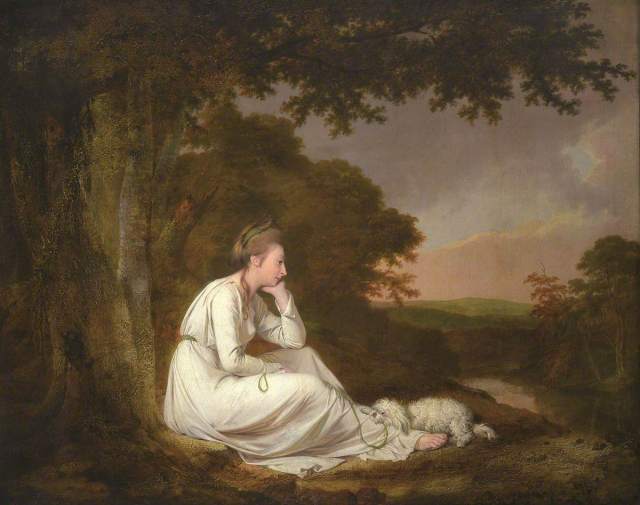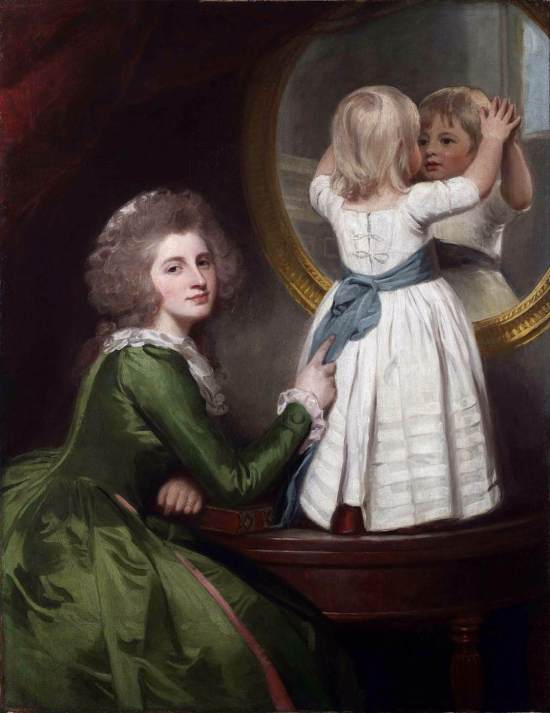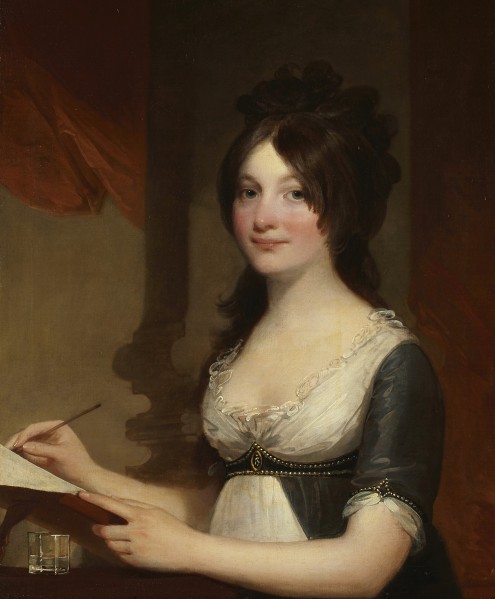Tag Archives: Romanticism
The comfort of dogs
 Heartbroken Maria, with her beloved dog, Sylvio, from Sterne’s A Sentimental Journey (1768) by the great Joseph Wright of Derby.
Heartbroken Maria, with her beloved dog, Sylvio, from Sterne’s A Sentimental Journey (1768) by the great Joseph Wright of Derby.
Ferens Art Gallery. Image source: All Things Georgian an essential online guide to the society and culture of the British 18th century.
“Her goat had been as faithless as her lover; and she had got a little dog in lieu of him, which she had kept tied by a string to her girdle: as I looked at her dog, she drew him towards her with the string.—“Thou shalt not leave me, Sylvio,” said she. I look’d in Maria’s eyes and saw she was thinking more of her father than of her lover, or her little goat; for, as she utter’d them, the tears trickled down her cheeks.” From ‘Maria’, in A Sentimental Journey Through France and Italy by Laurence Sterne (1768)
Maria is another casualty in the line of emotionally abandoned girls, like Ophelia, driven out of her mind by grief from a lover’s desertion and a father’s death, and Marianne Dashwood, whose excess of 18th century sensibility is the same as a major depressive disorder today, and real-life sisters, Sally and Maria Siddons.
Summer fires
‘All in the golden afternoon
….
In such an hour,
Beneath such dreamy weather,
To beg a tale…
“There will be nonsense in it!”‘
Lewis Carroll, preface to Alice’s Adventures in Wonderland, 1865
 Thomas Gainsborough Landscape with a Woodcutter and Milkmaid 1755
Thomas Gainsborough Landscape with a Woodcutter and Milkmaid 1755
Oil on canvas
“Nostalgia is denial. Denial of the painful present.
The name for this denial is Golden Age thinking – the erroneous notion that a different time period is better than the one one’s living in – it’s a flaw in the romantic imagination of those people who find it difficult to cope with the present.”
Midnight in Paris, 2011, film written and directed by Woody Allen
“Say not thou, What is the cause that the former days were better than these? for thou dost not enquire wisely concerning this.”
Ecclesiastes, Chapter 7, Verse 10, King James Bible, 1611
 John Constable (1776-1837) Coast Scene at Brighton: Evening, oil painting, ca. 1828
John Constable (1776-1837) Coast Scene at Brighton: Evening, oil painting, ca. 1828
© Victoria and Albert Museum, London.
“….colours from the sunset take:
From something of material sublime
Rather than shadow our own soul’s day-time
In the dark void of night.”
(Keats, Epistle to John Hamilton Reynolds)
“Set yourself on fire with passion and people will come for miles to watch you burn”
attributed to John Wesley (1703-1791)

“The people who started the moorlands fires are responsible for a catastrophe that has endangered an enormous number of people. People are having to evacuate their homes, livestock has been lost and natural beauty spots have been ravaged. Resources have been sent from fire and rescue services all across the country.” Fire Brigades Union general secretary Matt Wrack speaking of the wildfires on Saddleworth Moor, Lancashire, England, which spread for 2 weeks during the heatwave of late June and July, 2018
while they could see there was nothing left that glittered through the smoke ahead,
and the smell of burnt dirt did not stop rising from the ashes.
‘Catch on fire and people will come for miles to see you burn’.”
Noëlle Mackay Human Rites
 Thomas Gainsborough (1727-1788) Wooded Landscape with Herdsman and Cattle
Thomas Gainsborough (1727-1788) Wooded Landscape with Herdsman and Cattle‘And now the tale is done,
And home we steer, a merry crew,
Beneath the setting sun.’
Lewis Carroll (1832-1898), preface to Alice’s Adventures in Wonderland, 1865
Egocentrism before the Selfie Age

“Who in the world am I? Ah, that’s the great puzzle.”
Lewis Carroll, Alice’s Adventures in Wonderland (1865)
“To love oneself is the beginning of a life-long romance.”
Oscar Wilde, An Ideal Husband (1895)
“And you? When will you begin that long journey into yourself?”
Jalaluddin Rumi (1207 – 1273)

George Romney, Portrait of Lady Barbara Anne Russell née Whitworth
holding her son, Sir Henry Russell, “on one of the pier tables, playing with the looking glass”
(quoted from Sir Henry Russell’s memoir about the commission of the painting)
Oil on canvas, 1786/87. Last exhibited in ‘On Reflection’ at the National Gallery in 1998.
“That tragic, ruthless glance… is a question of his salvation…..
All the rest is rhetoric, posturing, farce”
Kierkegaard (1813 -1855)
“One of the mirrors in the house, an old pier glass inside a gilded oval frame that had lost its lustre a generation ago,
had cracked from too much self-reflection.
The more often they looked, the less clearly they saw themselves.“
Noelle Mackay, All the Rest (2017)
Gilded Dramas
Functional objects, vessels for light and fragrance, tables, clocks and other household accessories for the rich and powerful, gilt bronze status symbols that are also neoclassical sculptures of the finest art, piercing the soft darkness with their golden fluidity, making your jaded heart sing – I never understood ormolu before I saw The Wallace Collection’s current exhibition Gilded Interiors: French Masterpieces of Gilt bronze.
Video Gilded Interiors © The Wallace Collection 2017
And, in The Wallace Collection’s tradition for 117 years, entry to temporary exhibitions as well as to the permanent galleries is and always will be free. Liberty, Egality, Fraternity still exist in an Anglo-French union in Manchester Square, London W1.
It is a small exhibition, the pieces liberated by the curator from glass cases and cluttered rooms, out of the crude glare of museum electric lighting into simulated candlelight. The atmosphere is seductive. It is a tiny piece of gilded theatre. Continue reading
Everything I love
A Regency Romance (2)
At last, 11 days late, THE CAPTAIN’S WALLFLOWER has been released in the UK, but what do I care, I’m happy riding a hobbyhorse until I fall off….
 French fashion plate from Journal des Dames et des Modes, 1797, showing a lady riding sidesaddle, wearing a red and black “spencer” jacket with matching bonnet. Image from the irresistible Dames a la Mode
French fashion plate from Journal des Dames et des Modes, 1797, showing a lady riding sidesaddle, wearing a red and black “spencer” jacket with matching bonnet. Image from the irresistible Dames a la Mode
The Victorians and Edwardians revised Regency style for a contemporary audience, fed up with stuffy Victoriania, and in doing so drained the real Regency of its blood and guts, replacing Romanticism with romanticism, sense and sensibility with archness.

Supremely self-aware, the Countess of Blessington shares a candid moment with her portraitist Thomas Lawrence (Oil on canvas, 1814. Image: WGA) While enjoying her sexual charms, he notes her vitality and intelligence (she was a novelist, journalist and literary hostess). There’s nothing arch or simpering about the woman or the artist.
Lawrence was a celebrity flirt: every portrait session with him, whether you were a man or a woman, was a Regency Romance in itself.
Fictional Regency heroes, like their historical models, incarnate the classical ideal of a healthy mind in a healthy body. They are likely to have been trained on the playing fields of Eton, or Harrow, and fought at Trafalgar or Waterloo.
Snobbery is inherent to Regency Romance, but it is pervading film and theatre nowadays, too, answering an atavistic patriarchal need whether we like it or not..
An actor of over 50 years’ experience remarked to me the other day, after we’d rolled our eyes at all those Old Etonians monopolizing the best acting parts: “They teach charm at Eton”. It recalls the “Company of Youth”, the notorious Charm School of the Rank Organization in the 1940s and 50s. It is the equivalent of mass produced “antiqued” or “chateau” furniture.
Class-consciousness separated Keats from public school-boys Byron and Shelley, causing a gulf that only Shelley tried to bridge.
It’s reassuring to know that both the poetic rebel Shelley and the military hero/reactionary Conservative politician Wellington hated being at Eton.
The myth of the perfect English hero was consolidated in late Victorian fiction, partly by the Hungarian-born Baroness Orczy in The Scarlet Pimpernel, and explains the success of public school type actors today.
Sir Percy Blakeney is an invented 18th century, not Regency figure, but his characteristics are the same: masculine strength under a metrosexual exterior.
Ambivalence is essential to the Regency hero’s sex appeal – and a sense of humour.
Sexual attraction combined with rom-com plot is essential to Regency Romance, but so is an arcane, or snobbish, element contained in the jargon, which you have to understand if you are to master the etiquette and be accepted into the ton along with the always charmingly unconventional heroine. Regency Romance palliates the reader’s own social anxieties. If you can succeed at that assembly room ball, you can succeed anywhere. Continue reading
A Regency Romance
What explains the enduring appeal of the Regency Romance?
Why has that period in history lent itself more than any other to our fantasies about courtship and social acceptance? The origins of its potency lie older and deeper than the comedies of manners written prolifically by Georgette Heyer, the doyenne of Regency Romance fiction, and the costume rom-coms of the film and movie industries of the last hundred years.
Regency Romance is written to a winning formula nowadays, some of it blissfully unconcerned with syntax or history, but millions of women had fallen in love with Classic Literature’s Mr Darcy for nearly two centuries before the BBC got him wet. Members of all sexes have obsessed over the period’s dead poets with a sense of connection that felt stronger than many real relationships. Many a girl and boy have thrilled to Byron’s “mad, bad and dangerous” celebrity, or pined to be the one to soothe Keats’ fevered forehead, rather than inadequate Fanny Brawne.
We are all touched by the Regency, even those of us who have never read a romantic novel or would know a pelisse if it arrested us.

John Arthur Douglas Bloomfield, 2nd Baron Bloomfield, already a career diplomat at the age of seventeen, a pillar of the Establishment trying desperately to look like poet, libertarian political writer and social outcast Lord Byron, painted at full Romantic throttle by Thomas Lawrence, 1819. (National Portrait Gallery. Image: Wikipedia).
The Regency created its own romantically sexy myth long before it was appropriated by later generations.
The Regency period looks more modern to us than either the preceding 18th century age or the following Victorian age. The style of clothes and short hairstyles are still around – even the men’s tight-fitting trousers have been revived as jeggings.
Regency architecture, interior and garden design still provide some of the most elegant home improvement options available today.
 Edmund Leighton: On the Threshold (1900). Manchester Art Gallery. Image source: Wikipedia
Edmund Leighton: On the Threshold (1900). Manchester Art Gallery. Image source: Wikipedia
Love the wrought iron and lead roofed porch. And his boots….
A late Victorian nostalgia for Regency style packaged the romance of consumerism, in which props and set dressing are more prominent than feelings. You’d never guess from later illustrations that there had been a war going on, in fact several wars, about ideology, trade, territory and ideas.
Women’s clothes in the neoclassical Regency period, for three decades after the French Revolution, were more comfortable, more symbolic of personal freedom, than later 19th and early 20th century fashions. By the late 1820s, tight lacing was back and got tighter. (Traditional stays had never really gone away for every woman in Regency times, and were superseded by the much-maligned corset which, correctly fitted, is far more comfortable and good for posture than its reputation allows. And some of us are comfortable and happier in high heels, just as some people have sea legs – but that’s for another battle at the Last Post.)
The female body of the following four generations was squeezed in and padded out, satisfying somebody or other’s fetishes, some of them as weird as Comic Con costumes.
At the time Edmund Leighton was turning out his chocolate box historical genre scenes, and C.E. Brock was producing his fairytale illustrations to Jane Austen, fashionable women’s bodies were trapped in S-shaped cages which they only started getting out of shortly before World War I. The Regency looked like a time of rationality and enlightenment in comparison.

One of the later (1907) watercolour versions of C.E. Brock’s original 1895 illustrations to Pride and Prejudice: the sugary colours signal the export of Jane Austen’s “two inches of ivory” world to the arch land of Regency Romance.
to be continued
The audio version of A Worthy Wife by Barbara Metzger, read by Pippa Rathborne, is available now on Audible, Amazon and iTunes.
Epistolary (Half) Eschewed

Portrait of a Young Woman, writing a letter, by Gilbert Stuart, c. 1802 -1804. Image courtesy of the Indianapolis Museum of Art. I am sorry to have interrupted her; she is rather lovely, rather to be loved and written about than briefly employed as a cover girl.
All roads in this land lead to Pemberley. Jane Austen, the prosaic revolutionary, waits quietly, with gloves and bonnet on, at the crossroads of 18th century and modern novels. The bonnet conceals the expression in her eyes, which isn’t quiet at all.
Audio: Till this moment, I never knew myself
Pride and Prejudice, which seems so fresh and spontaneous on every reading, took eighteen years to evolve, from the first draft written in 1796-97 to publication in 1813. It had a gestation period almost as long as the heroine’s life at the stage when we first meet Elizabeth Bennet, aged 20. And which of us remembers anything before we are two, anyway?
Poor Clarissa Harlowe was only eighteen when her ordeals, recorded in epistolary form by Samuel Richardson, started.
Clarissa is an articulate, morally courageous young woman, not immature at all, whose fortitude and capacity to forgive her abuser overcomes adversity far more severe than any suffered by an Austen heroine – and yet she has martyr written all over her, which Elizabeth Bennet, Emma Woodhouse and Elinor Dashwood, even Marianne Dashwood, Fanny Price and Anne Eliot, do not.
Their creator gave them autonomy. They step off the page. They walk into our minds, and they get transplanted into other times and places. They dress and speak differently in all these reincarnations, their education and professions and leisure pursuits vary, but they are still recognizable, except, perhaps, when attacked by zombies.
They are not social rebels; they don’t demand equal rights. They would have been deterred by the violent excesses of the French Revolution which had just rocked Europe. The only revolutionary changes that take place are in their own heads.
They are not submissive and they refuse to be victims. They are paragons of self-improvement, never blaming other people or fate for their shortcomings.
They are intelligent young women, articulating a life of the mind richer and more independent than offered by ribbons, posies and billets-doux.

The Love Letter by Fragonard, 1770s. Image: WGA.
Arch, erotic and epistolary – the Rococo melted away with the advance of more demanding, independent-minded literary heroines.
Jane Austen began writing novels on the conventional epistolary model, and quickly abandoned it after Lady Susan (c. 1794), and the first draft of Sense and Sensibility (c. 1795). Continue reading
Summer disturbed

The Painter’s Daughters Chasing a Butterfly, one of Gainsborough’s intimate studies of his daughters made in the late 1750s, which took 18th century sensibility forward into a Romantic awareness of individual development through the senses. Image © copyright The National Gallery London
He sees beyond the fragile innocence of two little girls, in the glancing light of a fashionably Rousseauian childhood idyll, to a more profound understanding. He is not just a portraitist exploiting vulnerability and shimmering fabric; he is their father who loves them and worries about them.
He would prefer to think his daughters are happy and well, hale and whole, but he dared to paint the anxiety showing in their faces as they ran, clutching each other’s hands, through the sinister half-darkness of a wood, which is both catalyst and externalization of their unconscious minds.
Happiness as represented by the decoratively winged insect is always out of their reach; they experience, as Keats described, “the feel of not to feel it”.
Love and madness disturb a summer’s day two hundred and fifty years after two little girls chased a butterfly.
I try to imagine again my first happy impression of this painting, first seen on visits to the National Gallery, when I was no older than the girls in the picture had been when their father painted them.
I took for granted they were living the ideal childhood of which I could only dream, long before I knew for a fact that both girls suffered from a genetic mental disorder, and grew up into deranged middle-aged women.
I didn’t see the sadness in their eyes, because I didn’t want to see it. The mysterious twilit wood looked enticing, not forboding.
When we look at their father’s painting, in ignorance of biographical details about the girls, shouldn’t our hearts still ache for them, with some knowledge intuitively divined, as Keats put it, “without irritable reaching after fact and reason”?
Or do we always impose our own preconceived ideas on everything we see, until some bossy person lectures us about it?
Let’s not make the mistake of thinking that the girls would have fared better in our time. Nowadays, Mary and Margaret might be taken away from Thomas Gainsborough, who loved them so, and his unstable wife, whom he also loved, to be put into mental hospital or a lifetime of unreliable drug dependency.

The painter’s wife, Margaret Gainsborough, by Thomas Gainsborough, c 1779, when she was about fifty years old.
Image © The Samuel Courtauld Trust, The Courtauld Gallery, London
Imagine being both the painter and the parent of those little girls, chasing their butterfly, never being able to catch it.
One person’s wistfulness is another’s indifference. Nothing we see feels the same to the person in the picture. We congratulate ourselves on feeling so deeply about art that we must be good people or, at least, better than we thought we were a moment ago
Good or not, we cannot help the girls in the picture.
We chase the butterfly.

